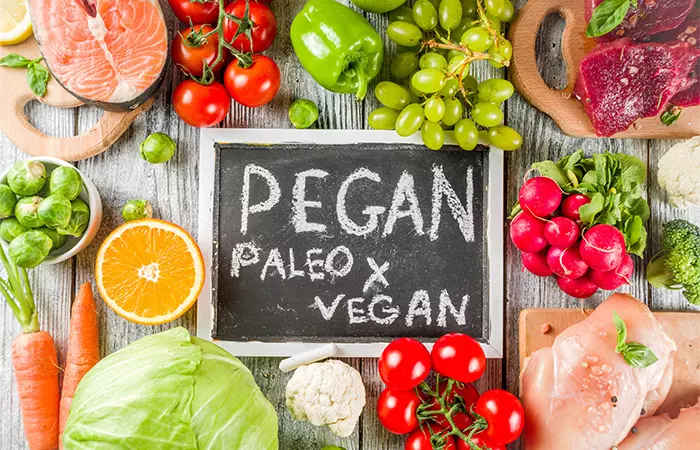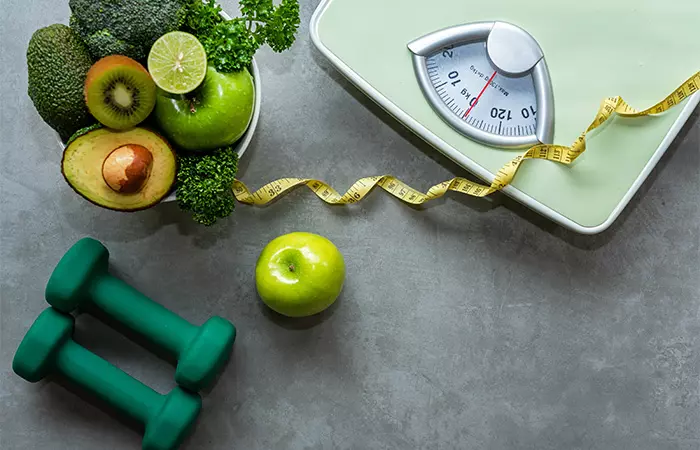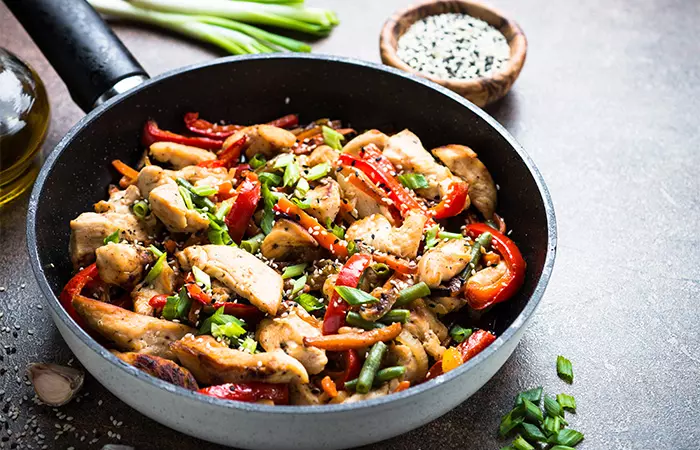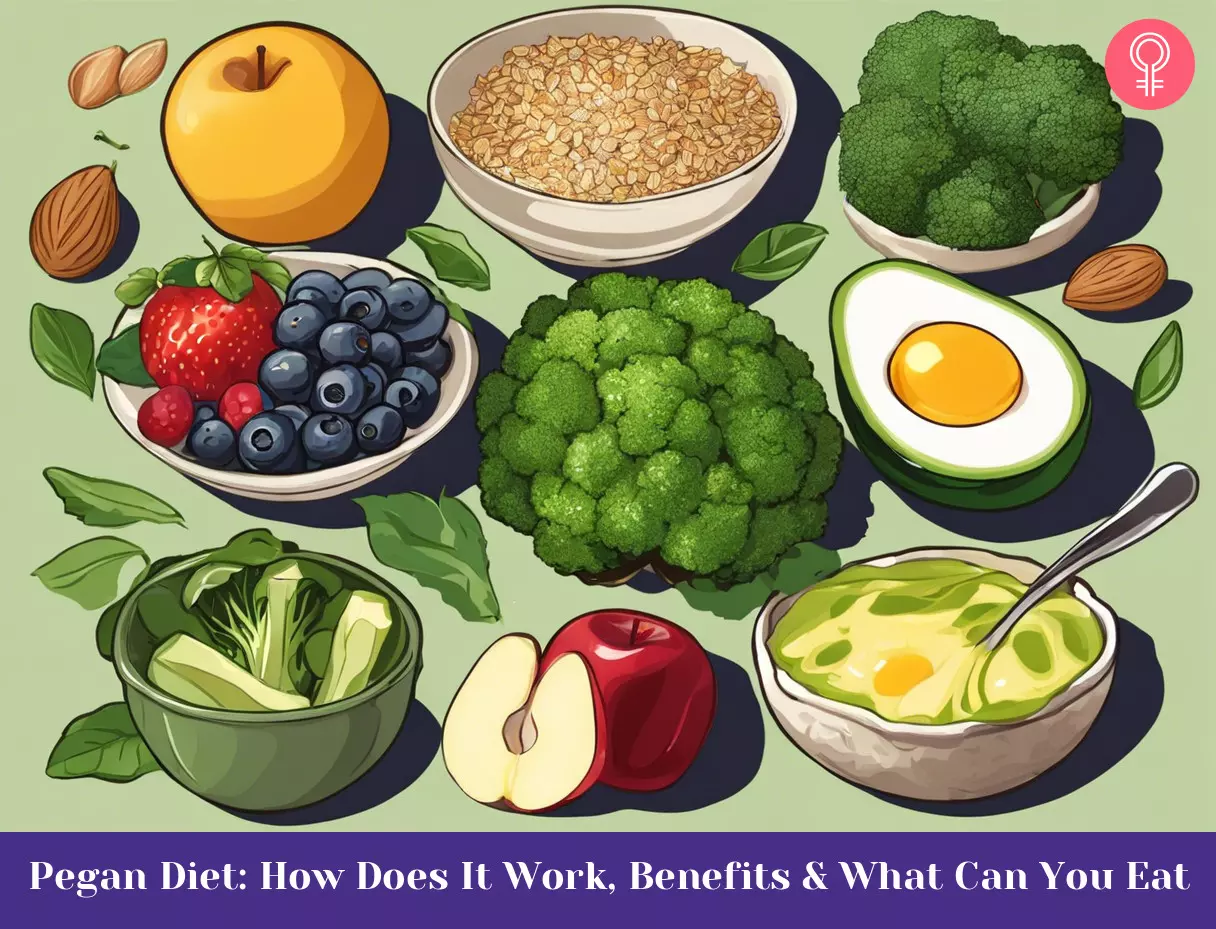What Is The Pegan Diet
The pegan diet is a hybrid diet option that combines aspects of the paleo and vegan diets. It limits or eliminates dairy products, grains, and legumes and includes whole, unprocessed foods, such as vegetables, fruits, nuts, seeds, and healthy fats. It combines paleo’s emphasis on high-quality protein sources, like lean meats and fish, with the vegan dedication to ethical and environmentally friendly food choices. The pegan diet can be a flexible and inclusive option for anyone looking for a more mindful and health-conscious approach to eating, since it attempts to create a balanced and sustainable nutritional framework that supports overall health and well-being. But on what basis does this diet work? Let’s find out below.
How Does The Pegan Diet Plan Work
The pegan diet closely resembles a plant-based diet, but with the added inclusion of animal proteins, offering a more varied approach to nutrient intake. The pegan diet combines the principles of paleo and vegan diets, which makes it less restrictive with its own set of unique guidelines. The pegan diet works by:
Maintaining a principle strategy of consuming 75% plant-based foods and the remaining 25% of animal sources. Emphasizing eating whole fruits and vegetables with a moderate amount of meat, fish, legumes, nuts, and seeds. Minimizing the consumption of processed foods, refined sugar, grains, oils, and food items with artificial additives. Supporting sustainability by choosing locally and organically sourced foods.
These are the key principles behind the pegan diet; to know more about the advantages of this diet, keep reading!
Benefits Of The Pegan Diet
The pegan diet is focused on healthy eating, so it has many potential health benefits; although, there is limited research on it compared to other diets, and individual results of it may vary. Some of the advantages of the pegan diet involve: The pegan diet has many benefits as discussed, so to learn more about what food to eat and avoid on the pegan diet, scroll down!
What Foods To Eat On The Pegan Diet?
The pegan diet focuses on eating whole food that is rich in proteins and fats and has a lower glycemic load. Here’s a list of all the food items that you can have on a pegan diet:
What Foods To Avoid On The Pegan Diet?
The pegan diet is flexible yet strict in terms of restrictions on what cannot be consumed. Here’s a list of all the food items and ingredients that should be avoided in a pegan diet: To learn some amazing pegan diet recipes and how to plan meals, check out the section below!
Pegan Diet Recipes And Meal Plan
Pegan Diet Recipes
Ingredients
1 cup each of broccoli florets, sliced bell peppers (various colors), sliced carrots, snap peas, and sliced mushrooms 1 tablespoon of olive oil 2 garlic cloves, minced 1 tablespoon of tamari sauce (gluten-free soy sauce) 1 teaspoon of grated fresh ginger
How To Prepare 2. Quinoa Salad Ingredients
1 cup of cooked quinoa 1 cup each of diced cucumber and cherry tomatoes 1/2 cup of diced red onion 1/4 cup of chopped fresh parsley Juice of 1 lemon 2 tablespoons of extra-virgin olive oil Salt and pepper to taste
How to Prepare 3. Berry Protein Smoothie Ingredients
1 cup of almond milk or coconut milk 1/2 cup of all-season berries like blueberries, raspberries, and strawberries 1/2 cup of spinach or kale leaves 1/2 avocado 1 scoop of plant-based protein powder (ensure it’s pegan-compliant) 1 tablespoon of chia seeds Ice cubes (optional)
How To Prepare 4. Zucchini Noodles In Pesto Ingredients
2 medium-sized zucchinis, spiralized into noodles 1/2 cup of cherry tomatoes, halved 1/4 cup of chopped fresh basil leaves 2 tablespoons of pine nuts 2 tablespoons of extra-virgin olive oil 1 clove garlic, minced Juice of 1/2 lemon Salt and pepper to taste
How To Prepare
Pegan Diet Meal Plan
Day 1
Breakfast: 1 Omelet with ½ cup of bell pepper, onions, and tomatoes. Lunch: Veggie stir-fry with 1 cup of mixed vegetables like bell peppers, tomatoes, onions, and tofu. Snack: 1 Sliced apple with cinnamon. Dinner: 1 serving of baked salmon with 1 cup roasted Brussels sprouts.
Day 2
Breakfast: Berry protein smoothie containing 1 cup of mixed berries, ½ cup of spinach, and 1 scoop of plant-based protein powder. Lunch: Salad with 2 cups of kale leaves, ½ cup of chickpeas, 1/4 cup of avocado, and 1 cup of spinach. Snack: 1 cup of bell pepper with 2 tablespoons of guacamole. Dinner: 1 serving of grilled chicken (or mushrooms for a vegan option) with 1 cup of steamed broccoli and 1 cup of cauliflower rice.
Day 3
Breakfast: Chia seed pudding made with ½ cup of chia seeds,1 cup of almond milk with ½ cup of blueberries, ½ cup of strawberries, and 1 tablespoon of walnuts. Lunch: 1 serving of cauliflower rice and stir-fry with 1 cup of mixed veggies, and tofu or tempeh. Snack: 1 cup of carrot sticks with 2 tablespoons of almond butter Dinner: 1 serving of baked cod with 1 cup of sautéed spinach and 1 cup of quinoa.
Day 4
Breakfast: Green pegan smoothie containing 1 cup of spinach, ½ cup of avocado, 1 cup of almond milk, and 1 tablespoon chia seeds. Lunch: 1 cup of lentil and vegetable stew with salt and pepper. Snacks: ½ cup of roasted chickpeas Dinner: Stir-fried tofu with 1 cup of asparagus and 1 cup of zucchini noodles.
Day 5
Breakfast: ½ cup of avocado, a lettuce wrap with tofu, and ½ cup of sliced tomatoes. Lunch: 2 cups of mixed greens salad with ½ cup of chickpeas, roasted red pepper, and lemon-olive oil dressing. Snack: 2 dates and ¼ cup of nuts Dinner: 1 serving of grilled turkey with 1 cup of sautéed kale and 1 cup of sweet potato baked fries.
Day 6
Breakfast: Breakfast bowl with 1 cup of mixed berries, ½ sliced banana, 1 tablespoon of almond butter, a scoop of plant-based protein powder, and 1 tablespoon of chia seeds. Lunch: 1 cup of zucchini noodles with tomato-basil pesto sauce and 3 oz of grilled chicken breast.. Snack: 1 sliced pear with ¼ cup of walnuts. Dinner: Baked chicken thighs with 1 cup of roasted carrots and 1 cup of quinoa.
Day 7
Breakfast: 2 pancakes made with almond flour and eggs topped with fruits. Lunch: 1 cup of chickpea and spicy vegetable curry. Snack: 1 kiwi and ¼ cup of nuts Dinner: Thai curry with 1 cup of steamed green vegetables and tofu.
Although a pegan diet has many health benefits, there are some disadvantages as well. Check out the section below to be aware of them.
Drawbacks Of The Pegan Diet
The pegan diet also has some disadvantages owing to the strict restrictions on particular food items. These are:
Conclusion
The Pegan diet is a unique diet that combines the best of paleo and vegan diets to result in a novel approach to nutrition. It focuses on eating whole, lightly processed foods, which can result in a diet full of vitamins, fiber, and antioxidantsi Compounds in food that neutralize free radicals and inhibit oxidation to help prevent chronic diseases. . This diet has many advantages, as it helps in better blood sugar control, reduces inflammation, and improves weight management and overall health. However, it also has its drawbacks including strict dietary restrictions leading to high costs, and certain vitamin deficiencies. The pegan diet is not a one-size-fits-all diet, and it is tough to follow; hence, individual outcomes may vary. Before starting this diet, it is important to consult a healthcare professional or registered dietitian to ensure that it meets your unique health needs and objectives. Is coffee allowed on a pegan diet? Yes, coffee and tea are allowed in moderation on a pegan diet but sugar and dairy milk should not be used. Is the pegan diet keto? No, the pegan diet is not a keto diet, although they share similar principles. The former allows the consumption of a higher proportion of carbohydrates as compared to the keto diet. Can you eat cheese on a pegan diet? No, cheese is generally not allowed on a pegan diet as it leans towards plant-based products. Is popcorn allowed on a pegan diet? Yes, popcorn can be consumed in moderation but it should be prepared using a limited amount of olive oil instead of butter or refined oils. Can you drink almond milk on the pegan diet? Yes, almond milk is allowed on a pegan diet as it is plant-based milk that aligns with pegan diet principles. However, homemade almond milk is best as it allows you to control the ingredients. Are beans part of the pegan diet? Yes, beans like chickpeas, black beans, and lentils are allowed on a pegan diet as they are good sources of plant-based protein. What is the difference between the pegan diet and the Mediterranean diet? The Pegan diet emphasizes more on eating whole gluten-free food, while the Mediterranean diet focuses on whole grains, fish and poultry, wine, and sweets. Furthermore, the pegan diet has a more strict set of dietary principles, while the Mediterranean diet is very traditional and less restrictive. Is the pegan diet suitable for vegetarians or vegans? Yes, the pegan diet is suitable for vegetarians and vegans, although it emphasizes meat consumption. You can modify the diet by including only plant-based ingredients and protein substitute sources.
Illustration: Pegan Diet: How Does It Work Benefits & What Can You Eat
Discover the fusion of vegan and paleo diets by following this pegan diet. Learn about the health benefits of the pegan diet, as well as the foods to eat and avoid by watching this video, and embrace balanced nutrition.












